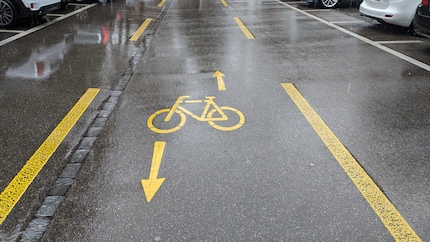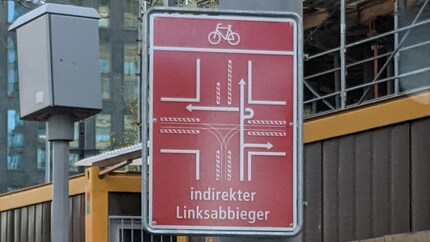
Background information
Pilot project in the Netherlands: forced braking for electric bikes
by Michael Restin

Non-motorised transport needs to be governed in a more sustainable, safe and simple way. And that’s exactly what the Swiss Federal Council is working towards. Guidelines from the think tank «World Resources Institute» show how that can be done.
Space is limited and crowds are dense. That’s what makes the following question so important: in future, how will cars, bikes and all kinds of e-vehicles be able to get around urban areas? In a recent report (in German) about traffic areas for non-motorised transport, the Swiss Federal Council sets out its vision for this in future. The Council also puts forward new regulations that grant more space for small electric vehicles. We’re set to see more e-bikes as well as electric vehicles in bike lanes, with the e-vehicle speed limit capped at 25 km/h. Higher speed e-bikes can use cycle paths as well as standard traffic lanes as long as they don’t go faster than 45 km/h. These vehicles are to be exempt from the moped ban in bike-only lanes. However, the pavement is to remain for pedestrians only.
With more cargo bikes and vans, e-bikes with trailers and fast speed-pedelecs being used, we need to find space for them somewhere. One option is to open up bus lanes for bike traffic. Another option is to allow various types of traffic to use different lanes depending on the time of day. Pro Velo welcomes the proposals, but mentioned in a press release (in German) that the paths would have to be wide enough. Flexible use alone is not enough. Instead, the space will need to be re-allocated to different groups on a regular basis. After all, the national cycle path act (in German) promises a connected network of safe routes.

In response to the pandemic, the Washington think tank «World Resources Institute» examined how functioning transport networks for vehicles like bikes can be created in urban areas. And the guidelines called «Safe Bicycle Lane Design Principles» were born out of that. They were designed to help cities come to good and speedy decisions on making cycle lanes appealing. In practice, this means paths that are safe and offer direct routes. However, safety shouldn’t just be measured by the number of accidents – something the Oslo guidelines also point to. The Norwegian capital rethought its strategy in 2015 to look at safety from a broader perspective to include perceived safety.
Having a low accident rate is not much use if older people, children or those who are more anxious feel that cycle paths aren’t navigable for them or consider them an aggressive environment. In Oslo, they managed to build trust with people and get feedback from them. This meant they could set up temporary bike lanes, which could then be adapted according to the public response. Way before pop-up bike lanes appeared as a result of the pandemic, the verdict was that flexibility is invaluable. Longstanding planning processes were able to bypass needs. «Set standards and stay flexible» is something Scandinavian planners have learnt. Compromise is necessary but it shouldn’t be at the expense of safety.
In Oslo, when public space was carved up, it proved time for a rethink. Previously, the 1.5 m section away from the kerb was allocated for bikes. But now bicycles are at the heart of discussion. The track width of cars, however, was adjusted. They’re left with the minimum: 2.75 to 3.25 m measured from the middle of the street. The rest is allocated to bike lanes. The key thing is that cycle paths have to be at least 2 m wide. If it’s still narrower in some places, speed limits and speed bumps help to slow traffic. The most important part is ensuring the bike path doesn’t just suddenly stop.
A practical approach ensures that what’s possible actually gets done and that safety is improved under these conditions. The result is an interconnected network that gets used and whose value is well communicated. This is because experiences are responded to and conflicts get defused. After all, aspects of the concept that seem logical are in no way always deemed sensible and sound. Getting people on board is a key part of implementing change. But as well as this soft factor and the Oslo example, the «Safe Bicycle Lane Design Principles» also contain plenty of concrete figures. For instance, on the amount of space bike lanes need.
Current cycle paths in conurbations are usually narrow. Something that’s standard today should be the exception to the rule as we look ahead. But, as in Oslo, we’ll need exceptions in order to create an interconnected network. This could be a way to design bike lanes in future:
When you make more space for the likes of bikes, there’s less room left for cars. And a narrower lane affects the speed. A metre less for cars can, in fact, drop the driving speed by 15 km/h.
This is a welcome side effect, as speed reduction is the next area that cities can and need to address. Even a metropolis such as Paris has implemented blanket speed limits (article in German) set at 30 km/h in order to reduce noise and emissions and improve safety. But wide bike lanes and altered speed limits aren’t the only solutions that are needed to ensure the infrastructure doesn’t fall into the bike trap. For example, consistent demarcation.
Where the speed limit is over 40, bike lanes should also be physically separated from the rest of the traffic. At first, by using temporary barriers or traffic cones, and perhaps later with plants or other solutions that protect cyclists from overtaking, shunting vehicles and car doors opening. Additionally, placing parking bays in the partition between cars and bikes would better help to protect cyclists and keep them well away from the flow of traffic. Until they get closer to a junction. Then it’s a case of ensuring the cycle path is visible and keeping out vehicles that are turning. To do this, you’ll need at least clear signals and enough space for cyclists to wait at the lights in front of the rest of the traffic.

In addition, technical solutions in Copenhagen involve extending the green phase for cyclists when there’s a high volume of traffic. This gives priority to two-wheeled vehicles and makes cycling more appealing than it was before. While it’s a nice concept, it could lead to more problems and an increasing number of accidents. In the Netherlands, there’s already a pilot project that automatically makes e-bikes brake in dangerous situations.
Where there’s a will, there will eventually be a good cycle way. But there will need to be compromises to ensure it’s used and accepted – it’s not just a question of safety. Other than that, it’s a case of realising that plans have to be put into action at some point and adapted using experiences gained. It’s about time. Slowly but surely.
Simple writer and dad of two who likes to be on the move, wading through everyday family life. Juggling several balls, I'll occasionally drop one. It could be a ball, or a remark. Or both.
Interesting facts about products, behind-the-scenes looks at manufacturers and deep-dives on interesting people.
Show all